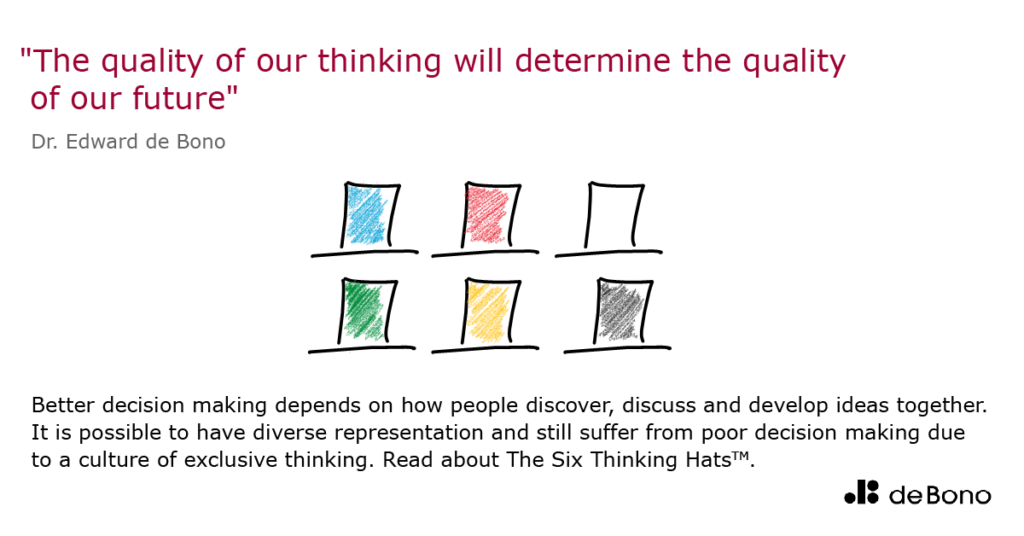When Caspar de Bono, now Managing Director of Edward de Bono, LTD. which represents the Intellectual Property of his father, Dr. Edward de Bono, called me and indicated he had two business consultants who were writing a book entitled The Business of Race and wanted to talk with me about the use of de Bono methods as a way to more effectively facilitate conversations about race, I was very interested. The initial conversation with them both, Margaret Greenberg, who is white and Gina Greenlee who is black, was stimulating to be sure. Their in-depth commitment to the issue of working on race in the world of business was crystal clear, as was their intent to find ways to make that dedication practically and effectively doable in the workplace.
Having heard of the process and read the book, the Six Thinking Hats, they attended and participated in the online program. In doing so, they experienced for themselves the credibility and effectiveness of the process and confirmed they would be including the Hats process in their book among the recommended tools for effectively addressing the issues of race in the workplace.
Continuing their thinking from The Business of Race, “Race talk is heavy lifting for sure. You must be fit. A body builder physique is not required but it does mean hitting the proverbial gym. Let’s look at the five core muscles you must build and strengthen to prepare for, advance and sustain the work. They are change readiness, cultural diversity, empathy, growth mindset and spectrum thinking.” The last, spectrum thinking, represents the work done and recommended by Greenberg and Greenlee with Six Thinking Hats.
Further, they say, “Change readiness, cultural curiosity, empathy and growth mindset—all skills that will facilitate productive race talk and race work. And here is one more muscle you’ll want to develop, and it has to do with thinking about how you think.” Greenlee and Greenberg go on to describe in The Business of Race, the use and working of Six Thinking Hats developed by Dr. Edward de Bono.
Given their commitment and statement of needed tools and methods, the de Bono Group, LLC is making a parallel pledge to addressing the issues of racism and prejudice. Our offer is to any director, officer or trainer who is part of a Diversity, Equity and Inclusion group a 20% discount on the regular price of the trainer certification. We offer this as a reflection of our core values as well as a way of positively supporting the work you do via Diversity, Equity and Inclusion aka DEI.

Companies are pursuing diversity and inclusion objectives to ensure a workforce that represents society and to enable better decision making. A principle of inclusion is to respect and value diversity in representation. Better decision making also depends on how people discover, discuss and develop ideas together. How meetings are run. It is possible to have diverse representation and still suffer from poor decision making due to a culture of exclusive thinking. Inclusive thinking is more than giving everyone an equal say. It requires an understanding of the modes of thinking that are used in meetings and how the meeting is structured. Inclusive meetings use a mechanism that respects and values diversity of ideas and makes for better decision making as those ideas are more fully explored.
The outcomes are motivated participants, more constructive contributions and better informed decisions. The meetings are more productive in that the outcomes achieved are greater for the time invested. Often this also means shorter meetings.
This method of parallel thinking is called the Six Thinking Hats. It was created by Dr. Edward de Bono. It is a simple language for organising and enabling inclusive meetings and better decision making. Teams use this to solve complex, contentious issues, effectively and quickly. It is achieved without defeating ideas or people. The approach is not about consensus and compromise but about a genuine exploration of the topic without taking sides. It is a method for creating value and encouraging people to change their own minds.
Dr Edward de Bono’s methods have been adopted through training programs by organisations around the world since 1991. Our global network includes certified trainers and facilitators in 72 countries through 18 training partners. We provide in person and virtual training and facilitation, supported by interactive digital courses and applications. We help you apply the methods to topics that are important to you. Our training partners can also organise the certification of in-house and independent trainers. All training partners offer corporate training, some distributors also provide public seminars.
Call us at the de Bono Group, LLC to discuss your needs and questions you have about the article. Inclusive thinking is a critical component to the diversity issue and the Six Thinking Hats program provides the tool-based approach to effectively develop and engage this important issue. 1-888-572- 2190 or email James P. (Pat) Carlisle at jpc@debonogroup.com
You may copy and republish this article and excerpts of it royalty free, on the condition that you link to and state “Republished under licence from the copyright holder deBono.com.